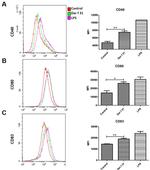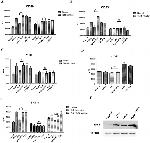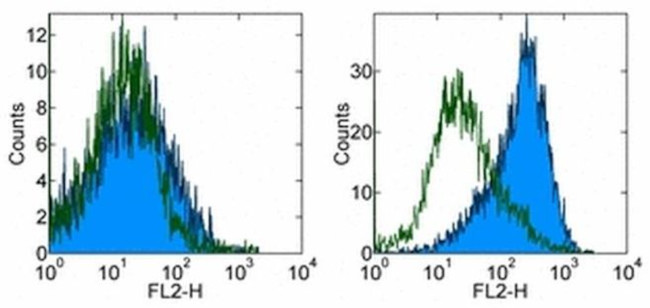Search Thermo Fisher Scientific
Invitrogen
CD83 Monoclonal Antibody (Michel-17 (Michel17)), eBioscience™
FIGURE: 1 / 4
CD83 Antibody (14-0831-82) in Flow




Product Details
14-0831-82
Species Reactivity
Published species
Host/Isotype
Class
Type
Clone
Conjugate
Form
Concentration
Purification
Storage buffer
Contains
Storage conditions
Shipping conditions
RRID
Product Specific Information
Description: The Michel-17 monoclonal antibody reacts with mouse CD83, a 45kDa cell surface glycoprotein and a member of the Ig superfamily. The mouse CD83 antigen is expressed predominantly on mature DC and activated lymphocytes. Cross-linking of CD83 with Michel-17 on DC or activated T cells does not induce any activation signal. CD83 plays an important role in T cell development through interaction with its ligand. CD83-Ig protein has revealed the presence of a CD83 ligand expressed mainly by B220^+ cells in mouse spleen.
Applications Reported: The Michel-17 (Michel17) antibody has been reported for use in flow cytometric analysis.
Applications Tested: The Michel-17 (Michel17) antibody has been tested by flow cytometric analysis of LPS activated mouse splenocytes. This can be used at less than or equal to 0.5 µg per test. A test is defined as the amount (µg) of antibody that will stain a cell sample in a final volume of 100 µL. Cell number should be determined empirically but can range from 10^5 to 10^8 cells/test. It is recommended that the antibody be carefully titrated for optimal performance in the assay of interest.
Purity: Greater than 90%, as determined by SDS-PAGE.
Aggregation: Less than 10%, as determined by HPLC.
Filtration: 0.2 µm post-manufacturing filtered.
Target Information
CD83 cell surface antigen is a 40-45kD glycoprotein expressed by peripheral blood dendritic cells. Peripheral lymphocytes can be induced to express very low levels of CD83 after culture in agents such as Con A or PHA. In immunohistology, CD83 is shown to be expressed strongly by interfollicular interdigitating reticulum cells and more weakly by cells within germinal centres. CD83 is also expressed by Langerhan's cells in the skin. The CD83 antigen is a 186-amino-acid single-chain glycoprotein and this molecule is a member of the immunoglobulin superfamily that is composed of an extracellular V-type Ig-like single domain, a transmembrane region, and a short, 40-amino-acid cytoplasmic tail. CD83 antigen undergoes extensive post-translational glycosylation, since the determined Mr is twice the predicted size of the core protein. However, CD83+ cells have a unique cell surface immuno-phenotype that does not correlate with that of T cells, B cells, NK cells, or cells of the myelomonocytic lineage. CD83+ cells coexpress the highest levels of MHC class II molecules, when compared with other leucocyte lineages. They also co-express T cell markers (CD2, CD5), B cell markers (CD40, CD78), myeloid cell markers (CD13, CD33, CD36), cytokine receptors as well as other cell surface molecules. Diseases associated with CD83 dysfunction include plague and Rift Valley Fever.
For Research Use Only. Not for use in diagnostic procedures. Not for resale without express authorization.
Bioinformatics
Protein Aliases: CD antigen CD83; CD83; CD83 antigen; mCD83
Gene Aliases: Cd83
UniProt ID: (Mouse) O88324
Entrez Gene ID: (Mouse) 12522

Performance Guarantee
If an Invitrogen™ antibody doesn't perform as described on our website or datasheet,we'll replace the product at no cost to you, or provide you with a credit for a future purchase.*
Learn more
We're here to help
Get expert recommendations for common problems or connect directly with an on staff expert for technical assistance related to applications, equipment and general product use.
Contact tech support
